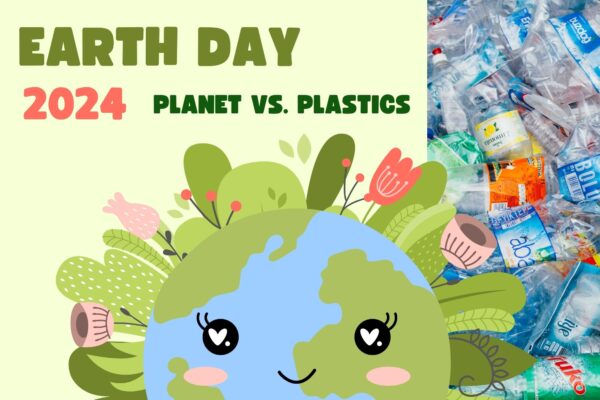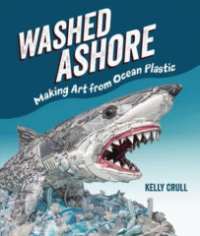
Earth Day is always on the same day every year, April 22nd. Earth Day is all about protecting the environment and figuring out what we can do to help. Every year, a unique theme addresses a topic of concern. This year, the topic is “Planet vs. Plastic”. In this blog post, you will find fun facts about Earth Day and how to reduce plastic use.
Earth Day Facts
How can I reduce waste and overuse of resources and make everyday eco-friendly choices?
Books
Plastic bags are cheap and easy to use. But what happens when a bag breaks or is no longer needed? In Njau, Gambia, people dropped the bags and went on their way. One plastic bag became two. Then ten. Then a hundred.
Upcycled Plastic Projects by Marcy Morin and Heidi E. Thompson
What to do with old plastic toys, bottles, jugs, and bags? Recycling is great, but upcycling is better! Repurpose old plastic into cushy pillows, quirky troll villages, and a funky bird feeder! Get eco-creative with more than ten easy, upcycled crafts.
What a Waste by Jess French
Everything you need to know about what we’re doing to our environment, good and bad, from pollution and litter to renewable energy and plastic recycling. This environmental book will teach keen young ecologists about how our actions affect planet Earth. Discover shocking facts about the waste we produce and where it goes. Did you know that every single plastic toothbrush ever made still exists? Or that there’s a floating mass of garbage more significant than the USA drifting around the Pacific Ocean? It’s not all bad news, though. As well as explaining where we’re going wrong, What a Waste shows what we’re doing right! Discover plans already in motion to save our seas, how countries are implementing schemes that have a positive impact, and how your waste can be turned into something useful. Every small change helps our planet!
Plastic: Past, Present, and Future by Eun-Ju Kim
Plastic use is a big problem, but when did we start using plastic? And why? Start a journey through the life cycle of plastic to learn how plastics are produced, the many uses of plastics throughout the last century, how our plastic use has spiraled out of control, and some ideas for what we can do about it. The whole story about plastic is filled with information to empower children to make choices that will affect their future.
Black Beach: A Community, an Oil Spill, and the Origin of Earth Day by Shaunna and John Stith
Based on actual events, this picture book tells the story of the first Earth Day through the eyes of a young girl named Sam.
Earth Day by Emma Carlson Berne
Earth Day is a celebration of our beautiful planet. On this holiday, people come together to clean up land and water, plant trees, and enjoy nature. Sing along as you explore Holidays in Rhythm and Rhyme! Includes online music access.
The Last Straw: Kids vs. Plastics by Susan Hood
Hood’s poems highlight the threat of plastic and show how it hurts our planet’s health. You’ll discover how scientists use jellyfish snot and other methods to reduce plastic pollution faster. Hood then introduces readers to young activists standing up and speaking out for change– and inspires you to change how you think about plastic!
Washed Ashore: Making Art from Ocean Plastic by Kelly Crull
Angela Haseltine Pozzi makes animal sculptures from plastic that washes up on beaches. Photos of these sculptures are paired with facts about featured sea creatures and the impacts of plastic on sea life.
Recycle and Remake by Hélène Hilton
Discusses the importance of recycling and reusing materials while providing instructions for craft projects, including a party piñata, a bee hotel, and a cardboard castle.
Earth Day by Joanna Ponto
Describes the history and traditions of Earth Day, including crafts and recipes.
Earth Day by Linda Lowery
In simple text and illustrations, explain how and why Earth Day became an international holiday, calling global attention to the problems of pollution, environmental destruction, and waste of natural resources.
The Day the River Caught Fire: How the Cuyahoga River Exploded and Ignited the Earth Day Movement by Barry Wittenstein
After the Industrial Revolution in the 1880s, the Cuyahoga River in Cleveland, Ohio, caught fire almost twenty times, earning Cleveland the nickname “The Mistake on the Lake.” Waste dumping had made fires so routine that local politicians and media didn’t pay them any mind, and other Cleveland residents laughed off their combustible river and even wrote songs about it. But when the river ignited again in June 1969, the national media picked up on the story and added fuel to the fire of the recent environmental movement. A year later, in 1970, President Nixon created the Environmental Protection Agency, leading to the Clean Water and Clean Air Acts, and the first Earth Day was celebrated. It was a celebration, a protest, and the beginning of a movement to save our planet.
Earth Day-Hooray! by Stuart J. Murphy
A drive to recycle cans on Earth Day teaches the Maple Street School Save-the-Planet Club children about place value.
Earth-Friendly Earth Day Crafts by Veronica Thompson
Shares instructions for creating Earth-themed craft projects, including turning recycled paper into a barrette, giving old shoes new life with painted shark portraits, and building a beehive out of used straws.
Celebrating Earth Day by Elaine Landau
Read about what Earth Day means, Earth Day at school, and what you can do to keep our planet clean.




















